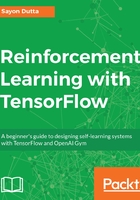
The cost function
The cost function is a metric that determines how well or poorly a machine learning algorithm performed with regards to the actual training output and the predicted output. If you remember linear regression, where the sum of squares of errors was used as the loss function, that is,  . This works better in a convex curve, but in the case of classification, the curve is non convex; as a result, the gradient descent doesn't work well and doesn't tend to global optimum. Therefore, we use cross-entropy loss which fits better in classification tasks as the cost function.
. This works better in a convex curve, but in the case of classification, the curve is non convex; as a result, the gradient descent doesn't work well and doesn't tend to global optimum. Therefore, we use cross-entropy loss which fits better in classification tasks as the cost function.
 input data), that is,
input data), that is,  , where C refers to different output classes.
, where C refers to different output classes.Thus, cost function = Average cross entropy loss (for the whole dataset), that is,
 .
.
In case of binary logistic regression, output classes are only two, that is, 0 and 1, since the sum of class values will always be 1. Therefore (for  input data), if one class is
input data), if one class is  , the other will be
, the other will be  . Similarly, since the probability of class
. Similarly, since the probability of class  is
is  (prediction), then the probability of the other class, that is,
(prediction), then the probability of the other class, that is,  , will be
, will be  .
.
Therefore, the loss function modifies to  , where:
, where:
If
 , that is,
, that is,  = -
= -  . Therefore, to minimize
. Therefore, to minimize  ,
,  should be large, that is, closer to 1.
should be large, that is, closer to 1.If
 , that is,
, that is,  = -
= -  . Therefore, to minimize
. Therefore, to minimize  ,
,  should be small, that is, closer to 0.
should be small, that is, closer to 0.
Loss function applies to a single example whereas cost function applies on the whole training lot. Thus, the cost function for this case will be:
